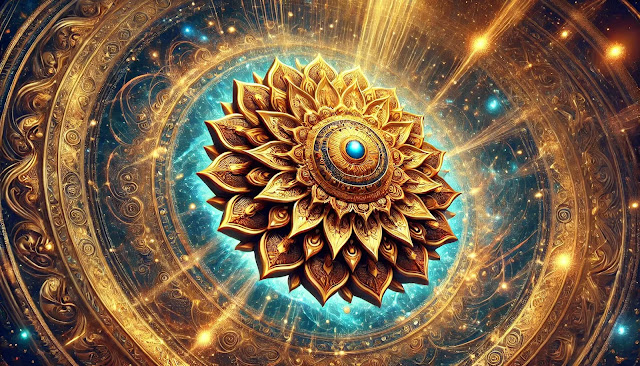Discover the mythological origins, symbolic significance, and historical journey of the Sudarshan Chakra, the divine weapon wielded by Lord Vishnu, representing cosmic order and the cyclic nature of time.
The Sudarshan Chakra: The Divine Weapon of Lord Vishnu and Symbol of Time
The Sudarshan Chakra, an enduring symbol of divine power and time, is one of the most iconic weapons in Hindu mythology. Wielded by Lord Vishnu, the preserver of the universe, this spinning, discus-like weapon represents both the cyclic nature of time and the annihilation of evil. With its razor-sharp edges and unstoppable force, the Sudarshan Chakra is not merely a tool of destruction but a profound symbol of cosmic order and righteousness.
Story of Its Creation
The origin of the Sudarshan Chakra is steeped in ancient lore. According to the Puranas, the Sudarshan Chakra was crafted by the divine architect Vishwakarma. It is said that Vishwakarma created this powerful weapon using the dust from the sun, which he obtained by reducing its size to make it less scorching for his daughter, Sanjana. Blessed with the energies of Lord Shiva, the Chakra was presented to Lord Vishnu to aid him in his mission to uphold dharma (righteousness) in the universe.
Another legend states that the Sudarshan Chakra was given to Vishnu by Shiva himself as a token of their alliance to protect the cosmos from demonic forces. It is a testament to the unity and cooperation among the deities in their cosmic responsibilities.
Status Among Different Divine Weapons
In the pantheon of Hindu mythology, the Sudarshan Chakra holds a preeminent status among divine weapons. While other formidable weapons like the Brahmastra, Shiva’s Trident, and Indra’s Vajra each have their unique powers, the Sudarshan Chakra stands out due to its association with time and its unparalleled destructiveness. It is capable of traveling at the speed of thought and is known to be unstoppable, returning to the wielder after completing its task. The Sudarshan Chakra's ability to cut through any material and its invincibility in battle make it one of the most feared and respected weapons in the mythological world.
Transmission from One User to Another Through Yugas
The Sudarshan Chakra, primarily associated with Lord Vishnu, has a significant history of being wielded by various divine figures across different yugas. This mighty weapon's journey through time highlights its enduring importance in Hindu mythology.
Satya Yuga
In the Satya Yuga, the Sudarshan Chakra was wielded by Lord Vishnu himself. It was during this era that Vishnu used the chakra to cut the body of Sati into pieces to pacify the grieving Lord Shiva, thus creating the Shakti Peethas, sacred sites scattered across India.
Treta Yuga
During the Treta Yuga, Vishnu incarnated as Lord Rama. Though the Sudarshan Chakra is not prominently featured in the Ramayana, it is believed that its divine presence continued to support the cosmic order and righteousness indirectly through Vishnu’s other manifestations and divine interventions.
Dwapara Yuga
The Dwapara Yuga saw Lord Krishna, another incarnation of Vishnu, extensively using the Sudarshan Chakra. Krishna employed the chakra to defeat many formidable foes, including the demon king Narakasura, thereby rescuing 16,100 women held captive. He also used it during the Mahabharata war to protect righteousness and destroy evil forces.
Kali Yuga
In the Kali Yuga, the chakra is said to be less visible in its direct use but remains a potent symbol of divine justice and cosmic order. According to some beliefs, the Sudarshan Chakra will again become active in the future when necessary to restore balance and order, possibly through future incarnations or divine interventions of Vishnu.
Divine and Mortal Wielders
Apart from Vishnu's avatars, the Sudarshan Chakra is also believed to be associated with other divine figures. For instance, Lord Shiva, Goddess Parvati, and even Sage Vishwamitra are sometimes depicted as wielders of this powerful weapon. Each usage by these divine beings underscores its role in maintaining cosmic order and destroying evil.
The transmission of the Sudarshan Chakra across yugas and various divine incarnations illustrates its timeless significance and the unbroken lineage of divine intervention in preserving dharma. This continuity emphasizes the eternal nature of cosmic justice and the divine responsibility to uphold righteousness through ages.
Literary Significance
The Sudarshan Chakra is not just a weapon but a profound symbol in Hindu literature. In texts like the Mahabharata, the Bhagavad Gita, and various Puranas, the Chakra is described with reverence and awe. It embodies the cyclical nature of time (Kala) and the inevitable destruction that follows creation, which is essential for the renewal of life and order.
In the Mahabharata, Lord Krishna uses the Sudarshan Chakra to create illusions and defeat his enemies strategically, demonstrating not just its physical prowess but also its symbolic significance in the cosmic order. The Bhagavad Gita, through Krishna’s dialogues, often alludes to the timeless nature of the universe, a concept metaphorically represented by the spinning Sudarshan Chakra.
Worship and Temples
The Sudarshan Chakra is not just a mythological artifact but also an object of worship. Temples dedicated to Lord Vishnu often house the Sudarshan Chakra as a key symbol of divine power. The Jagannath Temple in Puri, Odisha, is one such temple where the Sudarshan Chakra is prominently displayed and revered.
Devotees often pray to the Sudarshan Chakra for protection and the destruction of evil. Rituals and offerings are made to invoke its power, seeking blessings for courage and righteousness. Festivals celebrating Vishnu and his avatars frequently highlight the Sudarshan Chakra, emphasizing its role in the cosmic cycle and its protective attributes.
Final Thoughts
The Sudarshan Chakra, with its rich mythological heritage and profound symbolism, continues to be a beacon of divine power and cosmic order. From its creation by Vishwakarma to its revered status among divine weapons, and its literary significance, the Sudarshan Chakra remains a timeless symbol of the eternal battle between good and evil. Through worship and devotion, its legacy endures, reminding us of the eternal principles of righteousness and the inevitable cycles of time.

Comments
Post a Comment